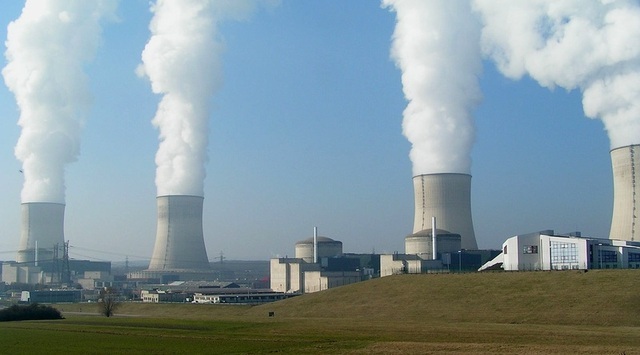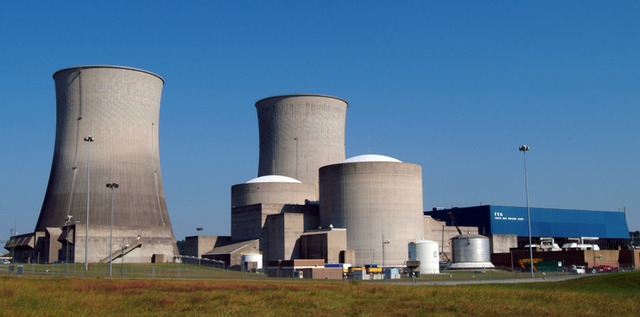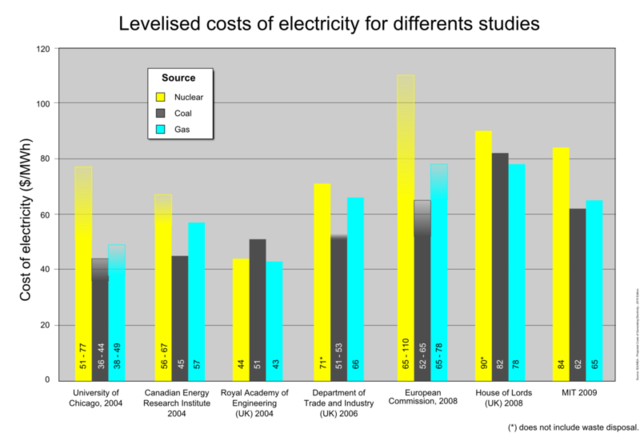
We may be at a critical point for nuclear power in the United States. The Nuclear Regulatory Commission (NRC) approved the construction of a new nuclear plant for the first time in 30 years—just two months after approving the reactor design. On the other hand, we're also approaching the first anniversary of the disaster at Japan's Fukushima Daiichi nuclear power plant. With these seemingly opposing events fresh in mind, now is the time to evaluate the status and future of nuclear power in the United States.
Interest in nuclear power stalled in the 1980s in the United States due to the high cost of nuclear plants and public perceptions of safety issues (particularly after the Three Mile Island and Chernobyl accidents). According to various polls, public support for nuclear energy has steadily increased in the past decade. In 2009, a majority of people in the US supported nuclear energy. After Fukushima, this dropped to 43 percent.
A recent report compiled by the Federation of American Scientists in collaboration with Washington & Lee University recognized the country's nuclear crossroads and decided to evaluate our situation. Their conclusion? The future of nuclear power in the United States is promising, but progress is likely to be slow.
In recent years, following rising fuel prices and concerns over global climate change, nuclear power came back into the spotlight. It is, after all, a potential carbon-free alternative to coal and natural gas. But without strong government support and some sort of emissions pricing to create incentives (not to mention sufficient safety considerations), we won’t see any nuclear revolution in the US.
Where are we?
In the current nuclear energy landscape, the US has 104 nuclear reactors in 65 power plants. This represents about a quarter of the total worldwide (441 reactors, with an additional 58 under construction). Today, nuclear power plants produce about a seventh of the world’s electricity and a fifth in the US. However, this is projected to decline to about 10 percent worldwide by 2030, due to both a rising demand for electricity and the retiring of older reactors.

Two-thirds of the US reactors are pressurized water reactors (PWR) and the remaining third are boiling water reactors (BWR). Both of these fall under the class of "light water reactors," which use normal water as both reactor coolant and neutron moderator (the moderator controls the speed of neutrons to keep the nuclear fission reaction proceeding). In contrast, "heavy water reactors" use—appropriately—heavy water (deuterium oxide, D2O, is water heavily enriched with deuterium).
Both types of light water reactors generate electricity by driving turbines with steam, as in coal power plants. They differ in how energy released by fission is used to create steam. BWRs dump the energy directly into surrounding coolant water, which boils into steam. PWRs, by contrast, transfer the fission energy to highly pressurized coolant water, which then flows through a heat exchanger to convert secondary coolant water into steam. The benefit is the secondary water stream is closed and doesn’t pick up any radioactivity. However, that's at the cost of requiring significantly stronger piping to withstand the higher pressure (typically around 15.5 megapascals, or 153 times atmospheric pressure).
(For a more in-depth explanation of how nuclear reactors operate, check out our recent coverage explaining the Fukushima nuclear crisis. MIT also has some free lectures on nuclear science and engineering released through their OpenCourseWare program).
Light water reactors run on enriched uranium. The enrichment is necessary because naturally occurring uranium has less than one percent uranium-235, the fissile isotope of uranium (the rest is uranium-238). Now, “enriched uranium” sounds scary because of the nuclear weapon connotations, but reactors only need around three to five percent enrichment. Nuclear weapons need more than 90 percent.
The first generation of nuclear power plants were the original prototype reactors built by the military and the initial power plants of the 1950s and 1960s. The current fleet of nuclear reactors, Generation II, were built primarily by Westinghouse and GE. The last nuclear reactor in the US began construction in 1977, although the Watts Bar Nuclear Plant was the last commercial reactor to come online (May 1996).
Many of these Generation II reactors had an original design life of 30 or 40 years. Now utilities are seeking license extensions for most of these. The NRC already extended the licenses of 70 reactors to either 50 or 60 years, and 15 other applications are under review as of July 1, 2011.

It’s all about the Benjamins
Proponents for greater use of nuclear power often tout its low cost and zero emissions. According to the US Energy Information Administration, electricity from nuclear power will cost 11.39 cents per kilowatt hour (kWh) in 2016. By comparison, conventional coal plants would generate electricity at 9.5 cents per kWh and onshore wind at 9.7 cents per kWh. Advanced natural gas plants offer by far the lowest cost at 6.6 cents per kWh.
However, it isn’t the cost of electricity that’s the problem. The largest barrier to more nuclear power plants may be the initial cost of construction. According to the report, the capital cost of nuclear plants always escalated over original estimates. The final costs of plants built through 1980—meaning all of them, since only one has been built since 1978—were on average 50 percent higher than comparable coal plants. This even includes retrofits to the coal plants to meet the higher emissions standards of the Clean Air Act.

Cost escalation remains an issue. A group of companies announced a two-reactor project in Texas in 2006, with an estimated cost of $5.2 billion. Three years later, the cost was revised to $10 billion, then $13 billion a few weeks later. The final estimate eventually reached $18.2 billion, over three times the original estimate. That's more expensive than an equivalently-sized natural gas plants, which also wouldn’t take nearly as long to build.
Considering the increasingly low price of electricity from natural gas, the report emphasized the need for some sort of carbon pricing to make nuclear attractive. Natural gas power plants are beginning to replace coal plants and they emit about half the greenhouse gases. Without a price on carbon dioxide emissions, nuclear power is actually more expensive than coal, oil, or natural gas, due to the massive upfront cost.
With this in mind, how can we fund nuclear power? Currently, the main route is through federal loan guarantees, where the government assumes the debt of the power utility if it defaults on its loans. The government awarded $8.3 billion in 2010 for two new plants in Georgia. The next year, the DOE requested $36 billion for loan guarantees. Keep in mind this money is only actually spent if the recipient defaults.
However, authors of the report contend the combination of the current deficit-spending environment and the high cost of nuclear plants (especially compared to natural gas) makes it difficult to defend continued loan guarantees from the federal government. Instead, they argue for a viable bond market to finance long-term projects like these. This would require, for example, stable Federal Reserve policies, low corporate tax and capital gain rates, a strong currency, and stable economic growth.
According to the report, the main obstacle to financing nuclear power plant construction is federal deficit spending. With a growing deficit, the supply of US Treasury bonds increases and corporate debt is either displaced or becomes more expensive. This makes it increasingly difficult to finance nuclear plant construction, outside of federal loan guarantees.
Safety and security concerns
Safety is another big issue with nuclear power plants—especially the public perception of safety. Following the accidents at Three Mile Island in 1979 and Chernobyl in 1986, the public lost confidence in nuclear power. Since then, a variety of safety improvements have been made in both the designs and operating practices of nuclear plants. According to the report, plant designs have been carefully analyzed and improved. Plants adopted safer operating practices, and the people operating the plants are better trained.
However, other groups such as the Union of Concerned Scientists (UCS) think the NRC can do a better job regulating nuclear power plants, especially regarding safety. In a 2011 report, they describe in detail 14 “near-miss” safety or security incidents occurring in 2009 and 2010. In a few of these, both the plant operator and the NRC knew about safety violations but did not take action. For example, at the Indian Point plant in New York, NRC inspectors knew about a leaky liner for refueling cavity since 1993, but took no action (saying that it only leaks when filed with water at a rate of two to 20 gallons a minute). Such a liner exists to prevent leakage if reinforced concrete walls crack during an earthquake, which it obviously could not do if already leaking.

The UCS report did acknowledge cases where NRC investigators discovered serious problems and took the appropriate actions to resolve them. The report concluded that while the NRC performed commendably in same cases, in general it enables lax behavior.
Many of the new safety improvements rely on passive rather than active systems. For example, instead of pumping coolant, passive safety features use gravity, natural circulation, and compressed air to cool the core and provide containment in an accident. These are not only simpler, but also lower cost since they require less complex components and supporting systems. By moving to passive systems, Westinghouse was able to reduce the number of valves by half, use 35 percent fewer pumps, 80 percent less pipe, and 70 percent less cable in an improved reactor design.
Ensuring the safety of nuclear plants from natural accidents is one thing, but providing for the security of plants from terrorist attacks is another entirely. In 2000, over 100,000 people lived in the 10-mile emergency zone around a fifth of nuclear sites. If safety systems were damaged enough, the resulting reactor core meltdown could release radiation to these close areas. This might sound unrealistic, but nuclear power plants were some of the targets considered for the 9/11 attacks.
After 9/11, the NRC and Congress took steps to improve security measures. Previous threat assumptions considered a team of three attackers helped by a single passive inside operative. The details of the new threat assumptions weren’t made public, but the capabilities of potential attackers were increased significantly.
Now, plants must be able to withstand attacks from a larger number of attackers (around five) and from multiple entry points, and who are willing to kill or be killed. In addition, the plants must be able to defend against both land and water vehicles, bombs, and cyber attacks such as the Stuxnet worm. However, even with these improvements, there are still questions about threats from terrorist groups. In particular, according to the report, aircraft attacks aren’t considered, even after 9/11.
One area the report didn’t address is the safety of extending reactor lifetimes. The NRC already approved license extensions of an additional 20 years for many reactors, and most (if not all) of the rest will probably also get extensions. The authors predict some of these could get further extensions, putting them at 80 years. According to a 2011 investigative report by the Associated Press, the safety reviews in this relicensing process aren’t always fully independent. They even cite instances where the NRC paperwork matches word-for-word with the application written by the plant operator.
These days, the NRC and nuclear power industry contend that the 40 year operating life was chosen for economic and regulatory reasons. According to them, nuclear plants have no technical lifetime limit. The AP investigation reviewed records and interviewed nuclear engineers who worked the designs, finding the opposite: the reactors were designed to only operate for 40 years.
reader comments
216